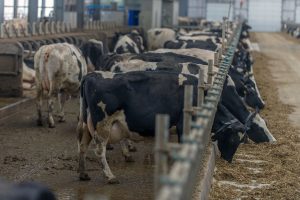
Dairy farmers across Europe are bracing themselves for an expensive 2022, followed by a journey into the unknowns of the new CAP in 2023.
They say conditions are very challenging for farmers aiming to respond to rising milk prices, by increasing supply.
Danish, German, French, Portuguese, and Irish milk producers have been telling the European Milk Board about their worries, and it is clear there is particular trepidation all the way into 2023 in Denmark and Portugal, caused by both countries’ CAP Strategic Plans.
The European Milk Board is made up of 21 dairy farmer associations, and the Landsforeningen af Danske Mælkeproducenter (LDM) in Denmark has told the EMB their new CAP will take away €23,597 from the average Danish dairy farm, in the redistribution of funds between Pillar I and Pillar II, with the government proposing to offset these losses with slaughter premiums for young stock.
The Associação dos produtores de leite de Portugal (APROLEP) told EMB that their CAP Strategic Plan ignored challenges for the country’s dairy sector, and instead proposed 100% convergence that reduces income support for dairy farmers by more than 50%.
Agrolep members are also apprehensive about a proposed new CAP payment for silage maize offering only half of the aid granted for grain maize.
EMB members across Europe came up with a litany of complaints that may help to explain the continent’s sluggish milk production in 2021, and poor 2022 prospects for increasing supply.
Danish dairy farmers say a national carbon tax is on the way which will add between 6 cents and 7.3 cents per litre of milk produced.
“We sincerely hope that politicians will also see it as a part of their responsibility to explain to retailers and consumers why farmers need a higher price for their products,” said LDM Chairman Kjartan Poulsen, who is a Vice-President of the EMB.
He said Danish farmers are also worried about the lack of young people to take over farms. “Anyone wanting to start producing milk faces huge challenges in every EU member state. Young farmers, in particular, have to deal with the investment capital required.”
LDM have calculated that the start-up capital in Denmark for a farm with 210 cows and 150 hectares of land is roughly €3.87 million.
There’s €2.3m for immovable property and fixed assets; €1.2m for funding herds, equipment and movable property; selling, general and administrative costs amounting to €70,000; and initial costs for feed, operating costs etc of €300,000.
LDM suggested financing the start-up capital requires an equity loan of €500,000 (9% interest rate), a mortgage loan over 30 years of €1.9m, a 15-year bank loan of €1m, and a working capital loan of €300,000.
This financing incurs annual interest and principal payments of €270,000, so the revenue per cow has to be €1,560, for all expenditure on interest, instalments and wages to be covered. The required revenue is €1,882 per cow if a farm manager’s remuneration is factored in.
According to LDM, it is virtually impossible for a young man or woman to finance a dairy farm in Denmark from their own funds. The Danish organisation says: “You have to have parents lending their child some of the money, or acquiring capital from people with money, or in some way sharing a farm for some time with the previous owner.
“That’s why farmers in Denmark are getting older and older, because they can’t sell their farm at a price that covers their loans for it. In the last 12 months, 5% of dairy farms have closed down. Farmland is easy to sell to financial funds, but not the livestock.”
That, says LDM, puts milk production in Denmark in a “tricky situation”.
Adrien Lefèvre, President of the Association des Producteurs de Lait Indépendants (APLI), told the EMB French dairy farmers also are having a hard time finding young people to take over farms. Dairy farmers in Ireland have zeroed in on the dramatic rise in fertiliser prices as the main 2022 worry.
The ICMSA is the Irish member of the EMB, and their Policy Officer Paul Smyth explained that fertiliser is an important input for Ireland’s spring-calving herds to maximise the grazing season and take full advantage of fresh grass.
“The hope is that a mild spring will lead to good growing conditions, easing some of the pressure on input costs,” said Mr Smyth.
According to EMB member Arbeitsgemeinschaft bäuerliche Landwirtschaft (AbL), in Germany, the milk production cost last October totalled 46.13 c/kg, but the farm-gate milk price was only 37.45 c/kg. Costs here are a calculation of the minimum price dairy farmers must be paid to cover the cost of production and generate a decent income for themselves and family members working on the farm.

























